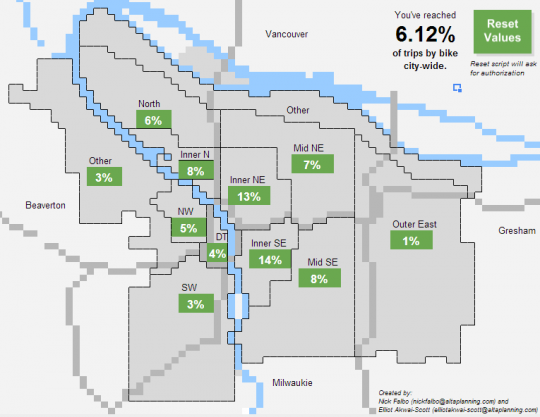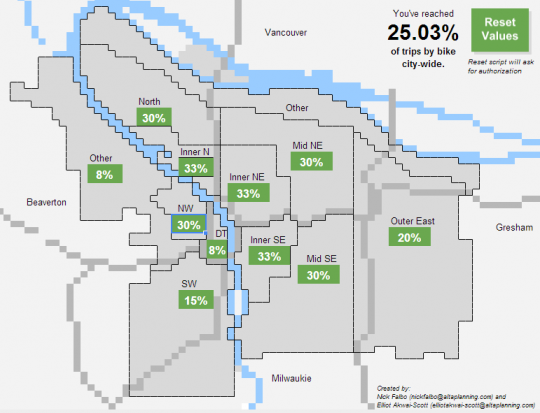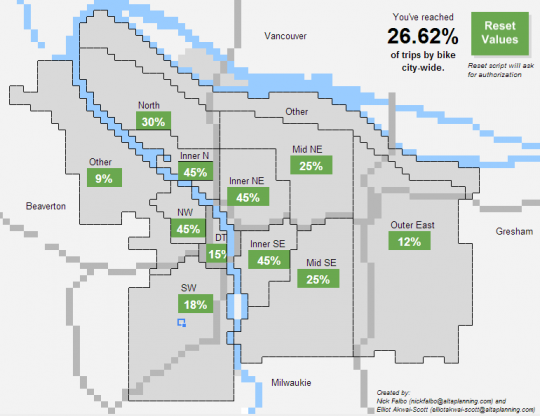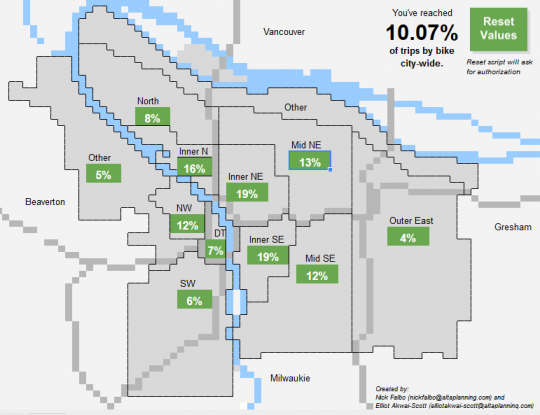
(Click to enlarge, or click here to play the spreadsheet-based game.)
The City of Portland’s official goal for 16 years from today is for one in four commutes to happen by bicycle, up from 6 percent today.
As many people have observed, that’s a tall order. But an ingenious new web game from two local planning pros lets you put your own hand to it.
Nick Falbo and Elliot Akwai-Scott, both of Alta Planning and Design, have created a Google spreadsheet with cells shaded and merged into a map of Portland. The current bike commute rate in each part of the city is labeled, and behind the scenes the sheet is tracking the population of each part of the city, too. When you adjust the commuting rate in a certain neighborhood — from 6.3 percent in North Portland to, say, 30 percent — you can see how the citywide total changes, too.
Because the game is based entirely in Google Docs, it doesn’t display well on phones or tablets. But if you have a Google account, it works like a charm in a desktop browser.
I tried a few ways to solve the puzzle. Here’s one way that takes a rough stab at what Portland bike coordinator Roger Geller says is most likely to work (PDF): substantially improving bike infrastructure everywhere, but focusing the heaviest investments in the central neighborhoods that were originally designed for streetcars, bikes and buggies rather than for cars.
The problem is that because the population of East and Southwest Portland is so huge (70,000 Portlanders live east of I-205), you need extraordinarily high bike-commute rates in the central city — almost as high as the bike-friendliest Dutch cities — to get to 25 percent.
Here’s a different scenario, in which we manage to distribute biking rates more evenly around the city:
The challenge in this scenario is thinking about how much work it’d take to boost East Portland’s bike commuting rate to almost twice the current rate in inner Southeast. It’s not just a question of proximity to jobs, after all: a big reason bike commuting into downtown is so popular is that downtown Portland charges for car parking. Even if Gateway became a major employment hub, it wouldn’t draw many bike commuters unless its businesses stopped giving parking spaces away for free.
Before publishing this post, I had one more idea I wanted to test: what if the bike-friendly parts of town got much more dense? How much difference would that make to the bike commuting?
So I looked up the city’s projections for future growth by quadrant, entered those into Falbo and Akwai-Scott’s behind-the-scenes spreadsheet, added 10,000 more people to every central area for good measure, and used my original scenario for biking rates by neighborhood.
It helped. But as you can see in the upper right, not a lot:
In an email to the Active Right of Way listserv, sharing this project, Falbo asked: “What’s the best way to 25%? Is is realistic to even think we can reach a mode share that high?”
This project makes it clear just how ambitious the city’s stated goals are. But it’s also a great way to get a sense for what is possible, and what it’d take to get there.
Update 4:50 pm: Commenter Allan R. suggests setting a different, shorter-term goal. How about 10 percent by, say, 2020? Former Portland Transportation Commissioner Tom Miller said in 2012 that the city was planning an interim target. Here’s what that might look like:





